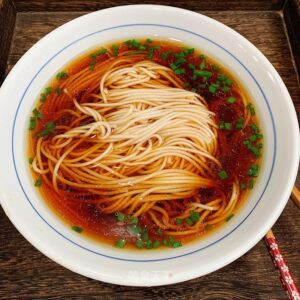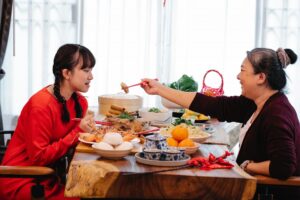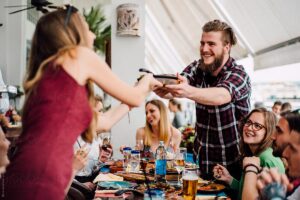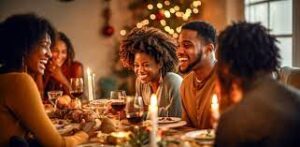Culinary Encounters and Memories: Who We Really Are

Summary
Culinary Encounters and Memories: Who We Really Are
Explore your personal relationship with food in this Open Toolkit. Delve into Huaiyang cuisine with an introductory video on "Yang Chun Noodles," reflecting cultural richness. Uncover your own food story, revisiting childhood memories and influential culinary figures. This toolkit guides you to articulate these experiences, emphasizing the role of food in shaping identity and emotions. Engage with a community of learners, sharing and discussing your culinary narratives. Concluding the journey, you'll find a deeper appreciation for your culinary heritage, personal growth, and the stories that define us.
Introduction of this Open Toolkits (2min)
Please watch the following video by playing it or clicking on the link provided.
https://media.ed.ac.uk/media/clip+of+yangchun+noodle+documentary/1_enz5gspt

In this captivating video, we take you into the world of a classic Huaiyang cuisine dish, “Yang Chun Noodles.” It’s more than just a dish; it’s a culture, a story, and a legacy of history. As you will see, behind every dish lies a wealth of emotions and profound personal experiences. Now, let’s continue this journey with “Culinary Encounters and Memories: Who We Really Are,” delving deeper into your connection with food and discovering how it shapes our identities and memories.
Now, welcome to “Culinary Encounters and Memories:Who We Really Are,” a journey to explore your personal food story. This Open Toolkit guides you to delve into the connections between food, your personal experiences, emotions, and cultural heritage. We will lead you to revisit childhood food memories, explore influential figures in your culinary perception, gather special recipes, and reflect on food-related traditions. This journey is more than a retrospective; it’s a process of self-discovery and growth, deepening your understanding of yourself and the world around you through the lens of food.
—————————————————————————————————————-
How to Write Your Own food Story: an Example(3min)

“Yang Chun Noodles and Memories of My Grandmother”
My grandmother was a master chef, her kitchen always filled with comforting sounds and aromas. Every morning when I was getting ready for school, she would prepare her specialty, “Yang Chun Noodles,” filling the house with a special kind of joy. I remember she would meticulously simmer chicken broth overnight, cook the springy noodles, and sprinkle them with shrimp roe. It was more than just a dish; it was her way of expressing love for me and emphasizing the tradition that “a good breakfast leads to a day without worries.”
She told me that “Yang Chun Noodles” originated from the ancient Huaiyang culture. They represent not only the ultimate pursuit of simplicity in ingredients and fine craftsmanship in cooking but also a cultural heritage. Sitting by her side, listening to her stories about the Huaiyang region, was one of the happiest parts of my childhood. In my grandmother’s small kitchen, I learned not just cooking, but also respect for food and appreciation for culture. Whenever the smooth, white noodles gently swayed in the golden, delicious chicken broth, I felt her love for life and her care for the family.
Now, even though I am far from my hometown, whenever I make “Yang Chun Noodles,” the familiar taste always takes me back to that kitchen full of love and stories. It’s not just a dish that represents Huaiyang cuisine; it’s an eternal emotional bond between me and my grandmother, a testament to the legacy of Huaiyang culture. It taught me the importance of a nutritious breakfast and to respect and appreciate our traditions. I realized that food is not just nourishment for the body; it’s a bridge connecting the past and the present, relatives, and memories.
—————————————————————————————————————————————————————————————————————————————
Writing Your Own Food Story (10min)
Now, why don’t you try to write your own food story?

Food Story Writing Guide:
Key Points Reminder
-
Authenticity: Keep your story authentic and personal. It’s about more than food; it’s about people and experiences.
-
Detailed Descriptions: Provide detailed sensory descriptions, such as taste, smell, and visual elements, to help the reader visualize the scene.
-
Emotional Connection: Let your emotions flow throughout the story, whether it’s happiness, nostalgia, or gratitude.
-
Exploring Your Personal Food Story
-
Reflect on Personal Experiences: Delve deeply into how food has shaped your views on reward and punishment, scarcity and abundance, work and leisure, etc.
-
Record Childhood Food Memories: In a notebook or your phone, jot down memories closely tied to food from your childhood, including the emotions you experienced and the people who were there.
-
-
The Beginning of Your Food Story
-
Choose a Special Dish: Select a dish that holds special significance to you, be it a family traditional dish, a local specialty, or any dish with a story.
-
Introduce Background and Emotional Tone: Briefly describe the background related to the chosen dish, like its origin, its meaning to you, or the first time you encountered it. Set the emotional tone of your story in a sentence or two, whether it’s a memory of joy, surprise, sorrow, or sadness. Guide the reader to open their heart and listen to your story.
-
-
Depicting the Scene and Characters
-
Describe Scene and Key Characters: Provide detailed descriptions of the scene and characters related to the dish, including important people who influenced your ideas about food, such as family members and friends.
-
-
Main Body and Traditions
-
Personal Experiences and Traditions: Narrate special memories or experiences related to the dish and the food traditions as you grew up, including everyday habits and special events.
-
Collect Recipes and Photos: Gather recipes featured in these memories and experiences, along with related photos or images.
-
—————————————————————————————————————————————————————————————————————————————
Story Collection and Presentation (5min)

Share your story in the area provided at the following link. Read, comment on, and discuss each other’s stories with fellow learners to form an interactive community.
Reflection and Change
-
-
Summarize and Self-Reflect: Review everything you have recorded and collected, and consider what it reveals about your relationships with others and your views on food.
-
Important Values and Changes: Think about what is most important to you throughout this process and what you want to preserve, create, collect, and share about your food story.
-
Actions and Changes: Note down any changes you wish to make based on what you have learned from your experiences and memories, whether it’s a family dining habit or commemorating a special practice for a loved one.
-
—————————————————————————————————————————————————————————————————————————————
In the End but Not the End for Your Food Story



